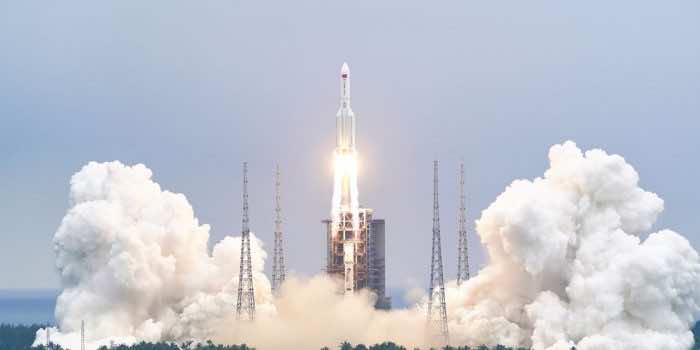China’s newest launch of a massive rocket has sparked fears that the debris would crash into the Earth’s surface at an unknown location and high speed.
The Long March 5B rocket lifted off from the Wenchang launch pad on the southern island province of Hainan on Sunday afternoon local time, carrying a solar-powered new lab, the Wentian experiment module, to be added to China’s Tiangong Space Station.
However, due to the apparent size of the heavy-lift rocket and the risky design of its launch process, experts are concerned that some debris from its core stage will not burn up as it reenters Earth’s atmosphere.

The rocket lost its empty 23-ton first stage in orbit, much like the last two flights, so it will continue to loop the Earth over the next few days as it gets closer to landing. It is challenging to predict this flight path due to atmospheric oscillations brought on by fluctuations in solar activity.
Although experts estimate the chances of debris striking a populated region are extremely low, many people believe China is taking an avoidable risk. After the latest launch’s core stage landed in the Indian Ocean, NASA Administrator Bill Nelson stated that China was “failing to meet responsible standards about their space debris,” including minimizing risks during reentry and being transparent about operations.
Even before the launch, Jonathan McDowell, an astronomer at the Center for Astrophysics who carefully follows space launches, tweeted that he hoped China would use a novel design that would allow the core stage to be actively deorbited.
McDowell added late Sunday that US Space Command orbital data on two launch vehicles indicated that the core stage “remains in orbit and was not actively deorbited.”
Many scientists agree with China that the chances of debris causing significant damage are quite low. For example, according to a recent paper published in the journal Nature Astronomy, the chances of someone dying or being hurt from pieces of a rocket performing an uncontrolled reentry are one in ten over the next decade.
Though, many people believe that unnecessary risks are posed by launch designs like the Long March 5B.
“Launch providers now have access to technologies and mission designs that might eliminate the need for the vast majority of uncontrolled re-entries,” the authors wrote.

The study suggested controlled reentry as a requirement for global safety standards. China’s spaceflight program has achieved notable symbolic victories in the past ten years as part of Chinese President Xi Jinping’s goal to turn the country into a space power, including the launch of the Tiangong Space Station last year, even though it lags behind the United States in several areas.
Concerns about a growing space race and the possibility of a disastrous catastrophe destabilizing the sudden upsurge in space activity have sparked international relations. However, since the Wolf Amendment, passed in 2011, forbids NASA from utilizing government funds to collaborate with the Chinese government, there has been very little space cooperation between China and the United States.

China’s expanding alliance with Russia, which Beijing claims is still strong despite President Vladimir Putin’s invasion of Ukraine, has further harmed prospects for international cooperation. Last year, the two made plans to work together to create a research outpost on the moon.


